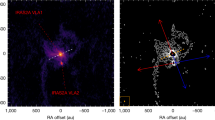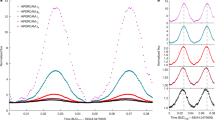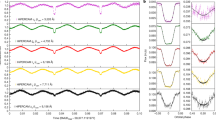Abstract
Almost all massive stars have bound stellar companions, existing in binaries or higher-order multiples1,2,3,4,5. While binarity is theorized to be an essential feature of how massive stars form6, essentially all information about such properties is derived from observations of already formed stars, whose orbital properties may have evolved since birth. Little is known about binarity during formation stages. Here we report high-angular-resolution observations of 1.3 mm continuum and H30α recombination line emission, which reveal a massive protobinary with apparent separation of 180 au at the centre of the massive star-forming region IRAS 07299-1651. From the line-of-sight velocity difference of 9.5 km s−1 of the two protostars, the binary is estimated to have a minimum total mass of 18 solar masses, consistent with several other metrics, and maximum period of 570 yr, assuming a circular orbit. The H30α line from the primary protostar shows kinematics consistent with rotation along a ring of radius of 12 au. The observations indicate that disk fragmentation at several hundred astronomical units may have formed the binary, and much smaller disks are feeding the individual protostars.
This is a preview of subscription content, access via your institution
Access options
Access Nature and 54 other Nature Portfolio journals
Get Nature+, our best-value online-access subscription
$29.99 / 30 days
cancel any time
Subscribe to this journal
Receive 12 digital issues and online access to articles
$119.00 per year
only $9.92 per issue
Buy this article
- Purchase on Springer Link
- Instant access to full article PDF
Prices may be subject to local taxes which are calculated during checkout




Similar content being viewed by others
Data availability
This paper makes use of the following ALMA data: ADS/JAO.ALMA#2015.1.01454.S, ADS/JAO.ALMA#2016.1.00125.S. The data are available at https://almascience.nao.ac.jp/aq by setting the observation codes. The data that support the plots within this paper and other findings of this study are available from the corresponding author upon reasonable request.
References
Chini, R., Hoffmeister, V. H., Nasseri, A., Stahl, O. & Zinnecker, H. A spectroscopic survey on the multiplicity of high-mass stars. Mon. Not. R. Astron. Soc. 424, 1925–1929 (2012).
Sana, H. et al. Binary interaction dominates the evolution of massive stars. Science 337, 444–446 (2012).
Peter, D., Feldt, M., Henning, Th & Hormuth, F. Massive binaries in the cepheus OB2/3 region. Constraining the formation mechanism of massive stars. Astron. Astrophys. 538, A74 (2012).
Almeida, L. A. et al. The Tarantula Massive Binary Monitoring: I. Observational campaign and OB-type spectroscopic binaries. Astron. Astrophys. 598, A84 (2017).
Moe, M. & Di Stefano, R. Mind your Ps and Qs: the interrelation between period (P) and mass-ratio (Q) distributions of binary stars. Astrophys. J. Suppl. Ser. 230, 15 (2017).
Kratter, K. M., Matzner, C. D., Krumholz, M. R. & Klein, R. I. On the role of disks in the formation of stellar systems: a numerical parameter study of rapid accretion. Astrophys. J. 708, 1585–1597 (2010).
De Buizer, J. M. et al. The SOFIA Massive (SOMA) Star Formation Survey. I. Overview and first results. Astrophys. J. 843, 33 (2017).
Reid, M. J. et al. Trigonometric parallaxes of massive star-forming regions. I. S252 & G232.6+1.0. Astrophys. J. 693, 397–405 (2009).
Tanaka, K., Tan, J. C. & Zhang, Y. Outflow-confined H ii regions. I. First signposts of massive star formation. Astrophys. J. 818, 52 (2016).
Keto, E., Zhang, Q. & Kurtz, S. The early evolution of massive stars: radio recombination line spectra. Astrophys. J. 672, 423–432 (2008).
Keto, E. The formation of massive stars by accretion through trapped hypercompact H ii regions. Astrophys. J. 599, 1196–1206 (2003).
Keto, E. & Wood, K. Observations on the formation of massive stars by accretion. Astrophys. J. 637, 850–859 (2006).
Guzmán, A. E. et al. The slow ionized wind and rotating disklike system that are associated with the high-mass young stellar object G345.4938+01.4677. Astrophys. J. 796, 117 (2014).
Zhang, Q., Claus, B., Watson, L. & Moran, J. Angular momentum in disk wind revealed in the young star MWC 349A. Astrophys. J. 837, 53 (2017).
Sakai, N. et al. Change in the chemical composition of infalling gas forming a disk around a protostar. Nature 507, 78–80 (2014).
Sridharan, T. K., Williams, S. J. & Fuller, G. A. The direct detection of a (proto)binary/disk system in IRAS 20126+4104. Astrophys. J. Lett. 631, L73–L76 (2005).
Beltrán, M. T. et al. Binary system and jet precession and expansion in G35.20-0.74N. Astron. Astrophys. 593, A49 (2016).
Beuther, H., Linz, H., Henning, Th., Feng, S. & Teague, R. Multiplicity and disks within the high-mass core NGC 7538IRS1. Resolving cm line and continuum emission at 0.06″ × 0.05″. Astron. Astrophys. 605, A61 (2017).
Kraus, S. et al. A high-mass protobinary system with spatially resolved circumstellar accretion disks and circumbinary disk. Astrophys. J. Lett. 835, L5 (2017).
McKee, C. F. & Tan, J. C. The formation of massive stars from turbulent cores. Astrophys. J. 585, 850–871 (2003).
Bonnell, I. A., Bate, M. R., Clarke, C. J. & Pringle, J. E. Competitive accretion in embedded stellar clusters. Mon. Not. R. Astron. Soc. 322, 785–794 (2001).
Myers, A. T., McKee, C. F., Cunningham, A. J., Klein, R. I. & Krumholz, M. R. The fragmentation of magnetized, massive star-forming cores with radiative feedback. Astrophys. J. 766, 97 (2013).
Takakuwa, S. et al. Spiral arms, infall, and misalignment of the circumbinary disk from the circumstellar disks in the protostellar binary system L1551 NE. Astrophys. J. 837, 86 (2017).
McMullin, J. P., Waters, B., Schiebel, D., Young, W. & Golap, K. CASA architecture and applications. ASP Conf. Ser. 376, 127–130 (2007).
Klaassen, P. D. et al. The evolution of young H ii regions. I. Continuum emission and internal dynamics. Astron. Astrophys. 611, A99 (2018).
Zhang, C.-P., Wang, J.-J., Xu, J.-L., Wyrowski, F. & Menten, K. M. Submillimeter array and very large array observations in the hypercompact H ii region G35.58–0.03. Astrophys. J. 784, 107 (2014).
Araya, E. et al. A search for formaldehyde 6 cm emission toward young stellar objects. II. H2CO and H110α observations. Astrophys. J. Suppl. Ser. 170, 152–174 (2007).
Liu, T., Wu, Y.-F. & Wang, K. A search for massive young stellar objects towards 98 CH3OH maser sources. Res. Astron. Astrophys. 10, 67–82 (2010).
Wilson, T. L., Rohlfs, K. & Hüttemeister, S. Tools of Radio Astronomy (Springer, Berlin, 2013).
Shaver, P. A., McGee, R. X., Newton, L. M., Danks, A. C. & Pottasch, S. R. The galactic abundance gradient. Mon. Not. R. Astron. Soc. 204, 53–112 (1983).
Schmiedeke, A. et al. The physical and chemical structure of Sagittarius B2. I. Three-dimensional thermal dust and free-free continuum modeling on 100 au to 45 pc scales. Astron. Astrophys. 588, A143 (2016).
Davies, B. et al. The Red MSX Source Survey: critical tests of accretion models for the formation of massive stars. Mon. Not. R. Astron. Soc. 416, 972–990 (2011).
Meynet, G. & Maeder, A. Stellar evolution with rotation. V. Changes in all the outputs of massive star models. Astron. Astrophys. 361, 101–120 (2000).
Lanz, T. & Hubeny, I. A. Grid of NLTE line-blanketed model atmospheres of early B-type stars. Astrophys. J. Suppl. Ser. 169, 83–104 (2007).
Mottram, J. C. et al. The RMS survey: the luminosity functions and timescales of massive young stellar objects and compact H ii regions. Astrophys. J. Lett. 730, L33 (2011).
Zhang, Y. & Tan, J. C. Radiation transfer of models of massive star formation. IV. The model grid and spectral energy distribution fitting. Astrophys. J. 853, 18 (2018).
Zhang, Y., Tan, J. C. & Hosokawa, T. Radiation transfer of models of massive star formation. III. The evolutionary sequence. Astrophys. J. 788, 166 (2014).
Beltrán, M. T. et al. Accelerating infall and rotational spin-up in the hot molecular core G31.41+0.31. Astron. Astrophys. 615, A141 (2018).
Ossenkopf, V. & Henning, T. Dust opacities for protostellar cores. Astron. Astrophys. 291, 943–959 (1994).
Zhang, Y., Tan, J. C. & McKee, C. F. Radiation transfer of models of massive star formation. II. Effects of the outflow. Astrophys. J. 766, 86 (2013).
Condon, J. J. Errors in elliptical Gaussian fits. Publ. Astron. Soc. Pac. 109, 166–172 (1997).
Sánchez-Monge, Á. et al. A candidate circumbinary Keplerian disk in G35.20–0.74N: a study with ALMA. Astron. Astrophys. 552, L10 (2013).
Ilee,J. D. et al. G11.92-0.61 MM1: a Keplerian disc around a massive young proto-O star. Mon. Not. R. Astron. Soc. 462, 4386–4401 (2016).
Acknowledgements
The authors thank N. Sakai for valuable discussions. ALMA is a partnership of ESO (representing its member states), NSF (United States) and NINS (Japan), together with NRC (Canada), MOST and ASIAA (Taiwan), and KASI (Republic of Korea), in cooperation with the Republic of Chile. The Joint ALMA Observatory is operated by ESO, AUI/NRAO and NAOJ. The National Radio Astronomy Observatory is a facility of the National Science Foundation operated under cooperative agreement by Associated Universities, Inc. Y.Z. acknowledges support from RIKEN Special Postdoctoral Researcher Program. J.C.T. acknowledges support from NSF grant AST1411527 and ERC Advanced Grant project MSTAR. K.E.I.T. acknowledges support from NAOJ ALMA Scientific Research Grant Number 2017-05A. D.M. and G.G. acknowledge support from CONICYT project Basal AFB-170002.
Author information
Authors and Affiliations
Contributions
Y.Z. led part of the ALMA observations, performed the data analysis, led the discussions and drafted the manuscript. J.C.T. led part of the ALMA observation, and participated in the discussions and drafting manuscript. K.E.I.T. contributed to the discussions. The rest of the authors discussed the results and commented on the manuscript.
Corresponding author
Ethics declarations
Competing interests
The authors declare no competing interests.
Additional information
Publisher’s note: Springer Nature remains neutral with regard to jurisdictional claims in published maps and institutional affiliations.
Supplementary information
Supplementary Information
Supplementary text, Supplementary references, Supplementary Figures 1–6.
Rights and permissions
About this article
Cite this article
Zhang, Y., Tan, J.C., Tanaka, K.E.I. et al. Dynamics of a massive binary at birth. Nat Astron 3, 517–523 (2019). https://doi.org/10.1038/s41550-019-0718-y
Received:
Accepted:
Published:
Issue Date:
DOI: https://doi.org/10.1038/s41550-019-0718-y
This article is cited by
-
Observations of high-order multiplicity in a high-mass stellar protocluster
Nature Astronomy (2024)



